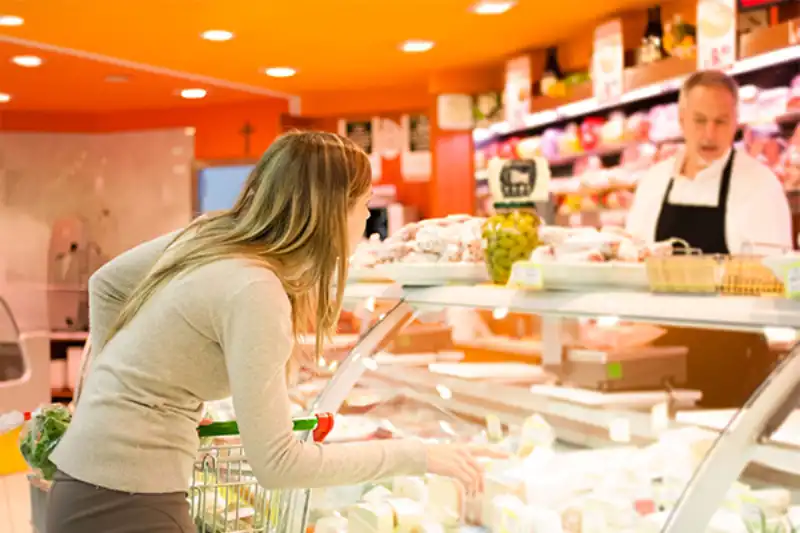Grocers are becoming America’s new favorite restaurants! Over the past decade, the revenue generated from freshly-prepared meals produced by grocers has nearly doubled to $28 billion in 2015. No longer simply the source of sliced deli meat, grocers now conveniently offer local customers delicious fresh offerings from taco bars to sushi counters to sophisticated multi-course meals. This food retail growth trend is only expected to expand over the next several years. However, substantially undermining the news of increased revenues from the newly diversified business, there is a corresponding significant increase in outbreaks associated with grocer’s operations. Grocers must properly prepare for this potentially catastrophic risk or face suffering a Chipotle-like contamination event, which could devastate the entire enterprise.
Grocers are excited because their stores are now being thought of as mini-restaurants and pubs – bringing in new customers with different and higher expectations. Grocers now operate local full-service restaurants offering sophisticated, multi-faceted meals. While the prospect for any grocer is exciting, the implication is simple: grocers must conduct the same food safety policies and procedures expected and required of restaurants. As Chipotle learned last year, serving fresh food while expanding operations can prove devastating to the brand and bottom line.
Critically, the risk of an outbreak from a food contamination event has increased faster than the fresh offerings trend. As the U.S. Centers for Disease Control and Prevention (CDC) recently reported, the number of outbreaks associated with grocers doubled over the course of a single year. From 2014 to 2015 the number of grocer-associated outbreaks doubled to 23 with 572 peopled sickened and 42 hospitalized. In 2015, New York State found that almost a third of the 15,600 violations involving grocers concerned prepared foods, many of which involved improper actions by employees.
With expanded operations come new and potentially catastrophic risks. In the context of a grocer’s newly expanded restaurant expansion, a simple but disastrous contamination scenario is not hard to imagine. The grocer’s new restaurant or expanded deli prepares and offers customers an exotic, complex, and very enticing dish. Unfortunately, the dish, served over several days, comes with a side of salmonella. An outbreak occurs, injuring local moms, dads, and children. Immediately, the grocer is involved in an extensive and intrusive governmental investigation involving the CDC, U.S Food and Drug Administration (FDA), and/or U.S. Department of Agriculture (USDA). When the media outlets, including blogs, publicize the news that the outbreak is linked to the grocer’s recently-opened restaurant or expanded deli, the grocer’s brand, reputation, and business are severely, if not catastrophically, damaged. The grocer’s restaurant or expanded deli, if not the entire operation, is closed while the FDA or USDA attempts to find and determine the source of the salmonella contamination. Meanwhile, the grocer’s customers start shopping at competitors’ stores.
While adding a new full-service restaurant or expanded deli will diversify a grocer’s operations, deliver new customers, and generate increased revenues, it also requires a different workforce with a specialized skill set, diversified employee training, complex safety policies and procedures, and expanded operations – a risk manager’s nightmare. Unlike many other types of hazards, grocers (and restauranteurs) cannot merely engineer-out food contamination risks. Nevertheless, grocers are able to significantly reduce their food contamination exposures when expanding and diversifying operations.
Product contamination insurance (PCI) and restaurant contamination insurance (RCI) are currently available and must be a consideration for any grocer looking to expand and diversify its business. PCI and RCI provide critical balance sheet and brand protection. Additionally, PCI and RCI can address the product contamination exposures found in every grocer’s supply chain. PCI provides coverage for accidental contamination, malicious tampering, products extortion, governmental recall, and adverse publicity. RCI covers insured events including foodborne illness, supplier contamination, public health authority announcement, malicious tampering, adverse publicity, workplace violence, product extortion, and disease outbreak.
If grocers properly consider PCI and RCI, they can enjoy the new revenue-generating trend of fresh product offerings because they will have appropriately reviewed and analyzed the right protection against the exposures involved with their newly expanded and diversified operations.
Will your company survive a product recall? Learn more about risk strategies for insurance buyers in the food and beverage industry at http://insurance.leavitt.com/foodrisks
CA License # OE22557





